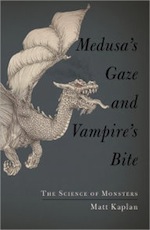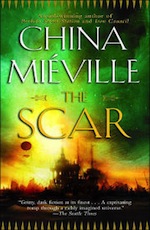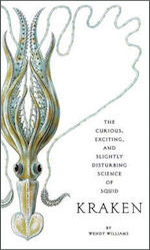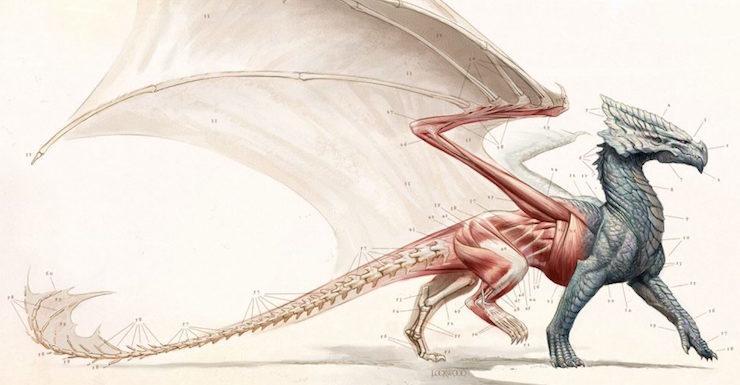I’ve written previously about gravity being monstrous. Above the clouds, gravity is that unreasonable force always waiting for someone to make a mistake.
When thinking about monsters for Updraft, I wanted to explore variety and opposites. Not all monsters take a quasi-human form, not all devour (though some of the great ones do). I looked at how monsters occur—whether from the dark corners of our subconscious, or from a darker side of our conscience. My research built a catalogue of characteristics that began with Grendel’s startling appearances and his mother’s grief in Beowulf, and reached all the way to black holes out at the wobbly edge of space. I did a lot of reading.
So I’m going to go off-road with this “Five Books About…” post and share with you two novels, two non-fiction books, and one book that falls somewhere in between. They’re filled with monsters, including creatures that don’t necessarily hew to traditional monster values. They rarely loom or stalk. They don’t usually lie in wait. They never sparkle.
These monsters are creatures going about their own business—business that is often truly beyond our understanding. Sure, many are predators, but so are we, even if it’s just at the grocery store. It’s only when humans intersect with these creatures, by invading their territory for instance, that they become monstrous to us. So when I say monstrous, I’m going past vampires and zombies. I’m talking about chimeras, krakens, yetis, rocs and more. From denizens of the deep to the bitey megafauna that cannot be reasoned with.
 The Memoirs of Lady Trent Series — Marie Brennan
The Memoirs of Lady Trent Series — Marie Brennan
In the ringing voice of a Victorian memoirist, Brennan captures the wonder of discovery when the narrator first sees dragons in the wild and begins, quite scientifically, to catalog their immense variety. The Lady Trent’s life and those of the dragons she studies are irrevocably intertwined, but the lady keeps a scientific eye on her subjects throughout A Natural History of Dragons, Tropic of Serpents, Voyage of the Basilisk, and the upcoming In the Labyrinth of Drakes.
 Medusa’s Gaze and Vampire’s Bite: The Science of Monsters — Matt Kaplan
Medusa’s Gaze and Vampire’s Bite: The Science of Monsters — Matt Kaplan
While Medusa’s Gaze is not the deep academic treatise it might want to be, it is a good survey of monster culture and the psychology behind it. From the bones of the dinosaurs and giant cats to their possible transformations past and future; from kraken to chimerae and more, Kaplan examines the evolution of monsters over human history.
 The Scar — China Miéville
The Scar — China Miéville
There are so many monsters and monstrous elements in The Scar. The avanc. The female Anophelli. The Grindylow. The Remade. The Lovers. The unfamiliar writ as monstrous. There is wonder too. And more familiar monsters envisioned as almost glamourous (the Vampir). There is the monstrous Armada itself. All of it and more spins together across the quest that lies at the heart of the book, and through the incredible world on the edge of Mieville’s Bas-Lag.
 Kraken: The Curious, Exciting, and Slightly Disturbing Science of Squid — Wendy Williams
Kraken: The Curious, Exciting, and Slightly Disturbing Science of Squid — Wendy Williams
This is a gorgeous book that covers so many aspects of cephalopod science, and the stories behind the science, that summing it up would do a disservice to science-journalist Williams’ writing. Exploring intelligence, camouflage, propulsion and fuzzy math, the mundane, and the diaphanous, Kraken takes readers on a journey while it informs.
 The Codex Seraphinianus — Luigi Serafini (with an introduction by Italo Calvino)
The Codex Seraphinianus — Luigi Serafini (with an introduction by Italo Calvino)
By turns disturbing and wondrous, grotesque and fantastical, the Codex is an illustrated volume of secret writing (via a cipher alphabet composed around an imaginary language). Each section deals with world description and categorization, albeit of usual variety. The illustrations tweak the senses and sometimes break the monstrous into mundane parts, while other times spinning the familiar into surreal abstraction. One reviewer, Baird Searles wrote in Asimov’s (April, 1984), said “the book lies in the uneasy boundary between surrealism and fantasy, given an odd literary status by its masquerade as a book of fact.” Originally published in 1981, several reprints have emerged.
Originally published in July 2015.
Fran Wilde’s novels and short stories have been nominated for three Nebula awards and two Hugo awards, and include her Andre Norton- and Compton-Crook-winning debut novel, Updraft (Tor 2015), its sequels, Cloudbound (2016) and Horizon (2017), and the novelette “The Jewel and Her Lapidary” (Tor.com Publishing 2016). Her short stories appear in Asimov’s, Tor.com, Beneath Ceaseless Skies, Shimmer, Nature, and the 2017 Year’s Best Dark Fantasy and Horror. She writes for publications including The Washington Post, Tor.com, Clarkesworld, iO9.com, and GeekMom.com. You can find her on Twitter, Facebook, and at franwilde.net










